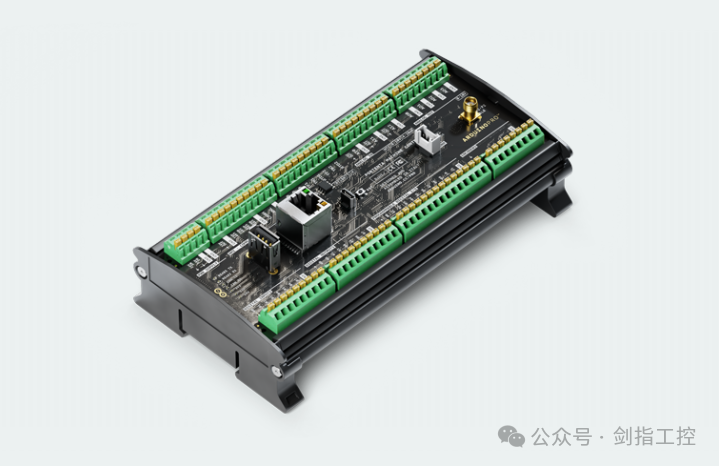
Introduction:
The development of industrial automation is inseparable from the application of PLC (Programmable Logic Controller). Traditionally, PLCs have typically used closed-source commercial products, but with the rise of open-source software and hardware, an increasing number of open-source PLC solutions have emerged. This article will introduce several open-source PLC projects, discussing their applications, advantages, and some potential challenges in industrial automation.
1
Arduino PLC
The Arduino PLC is an open-source PLC solution based on the Arduino development board, as shown in the figure below. It utilizes the Arduino development environment and a rich library of functions, allowing for easy programming and expansion. Advantages include high flexibility, ease of learning and use, and relatively low cost. However, due to the relatively weak computational power and communication performance of the Arduino PLC, it may not be suitable for large-scale and highly complex industrial automation systems.

Advantages:
High flexibility: The Arduino PLC can be customized for specific needs, adapting to different application scenarios. Easy to learn and use: The Arduino development environment and rich library functions make programming simple and understandable, even for beginners. Relatively low cost: The hardware and software of the Arduino PLC are relatively economical, suitable for projects with limited budgets.
Disadvantages:
Limited computational power and communication performance: The processing capability of the Arduino PLC is relatively weak, making it unsuitable for handling large-scale and highly complex industrial automation systems. Real-time performance may be insufficient: In applications with high real-time response requirements, the Arduino PLC may not meet the demands of real-time control.
2
Raspberry Pi PLC
The Raspberry Pi PLC is an open-source PLC solution based on the Raspberry Pi single-board computer, as shown in the figure below. It combines the powerful computing capabilities of the Raspberry Pi with a rich array of expansion interfaces, enabling complex control and monitoring tasks. Advantages include strong computational performance, extensive expansion capabilities, and flexible programming options. However, the real-time performance of the Raspberry Pi PLC may be relatively poor, making it unsuitable for applications with high real-time requirements.

Advantages:
Powerful computing capabilities: The Raspberry Pi PLC utilizes the high-performance processor of the Raspberry Pi, providing strong computational capabilities suitable for complex control and monitoring tasks. Rich expansion capabilities: The Raspberry Pi PLC offers multiple expansion interfaces, allowing easy connection of various sensors and actuators, extending the system’s functionality. Flexible programming options: The Raspberry Pi PLC supports multiple programming languages, such as Python and C++, allowing developers to choose the most suitable programming method based on their needs.
Disadvantages:
Real-time performance may not be ideal: Since the Raspberry Pi’s operating system is based on Linux, its real-time performance is relatively poor and may not meet the requirements of certain high real-time applications.
3
OpenPLC
OpenPLC is a powerful open-source PLC platform designed to provide a flexible, scalable, and user-friendly solution. Advantages include good compatibility, a graphical programming interface, and strong communication capabilities. OpenPLC can adapt to various hardware platforms while providing a friendly programming environment. However, for non-professional users, using the graphical programming interface may require some learning costs.
Advantages:
Good compatibility: OpenPLC supports various hardware platforms, such as Arduino, Raspberry Pi, and BeagleBone, allowing users to choose suitable hardware based on project needs. Graphical programming interface: OpenPLC provides an intuitive graphical programming interface, enabling non-professional users to easily create and modify PLC logic. Strong communication capabilities: OpenPLC supports various communication protocols and interfaces, such as Modbus, Ethernet, and CAN, facilitating communication with other devices.
Disadvantages:
Learning costs of the graphical programming interface: For non-professional users, using the graphical programming interface may require some learning costs. Performance limitations of certain hardware platforms: On some hardware platforms, OpenPLC may be constrained by hardware performance limitations, making it unable to handle more complex control logic.
4
Codesys
Codesys is a widely used open-source PLC development platform. It provides a complete software suite, including a programming environment, simulation tools, and runtime systems. Advantages include support for multiple programming languages, good compatibility, and a rich library of functions. Codesys has a wide range of application fields, and developers can choose the most suitable programming method based on their needs. However, commercial support and technical support for Codesys may be relatively limited, and some complex projects may require additional self-solution efforts.
Advantages:
Support for multiple programming languages: Codesys supports the five programming languages specified in the IEC 61131-3 standard, allowing developers to choose the programming method that best suits their needs. Good compatibility: Codesys can be integrated with various hardware platforms and peripherals, offering good compatibility. Rich function library: Codesys provides a rich function library, including commonly used control algorithms and communication protocols, facilitating rapid application development.
Disadvantages:
Limited commercial and technical support: Compared to some commercial PLC solutions, Codesys’s commercial and technical support may be relatively limited, requiring additional self-solution efforts for some complex projects. Steep learning curve: Codesys has relatively complex functions and programming options, which may require a certain amount of time and effort for beginners to master.
Conclusion:
Open-source PLCs bring innovative power to the field of industrial automation. Open-source PLC projects such as Arduino PLC, Raspberry Pi PLC, OpenPLC, and Codesys each have different characteristics and advantages, suitable for different scales and complexities of application scenarios. However, it should be noted that open-source PLCs may face challenges in real-time performance, computational power, and commercial support. As the open-source community continues to grow and technology evolves, open-source PLCs will continue to play an important role in driving innovation and progress in industrial automation technology.
April 2024
1. Smart200 & V90 Servo System: Updated 15 Lessons
2. Beckhoff Live Courses: Updated 30 Lessons
3. PKS Quick Start: Beginner & Intermediate – Full
